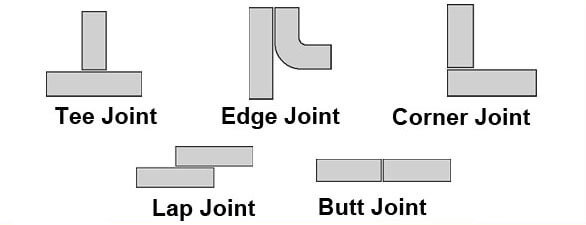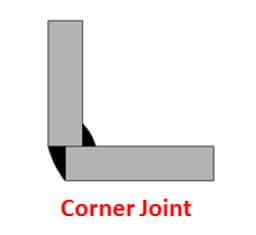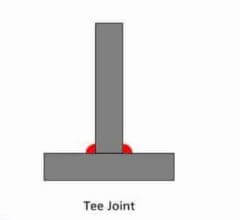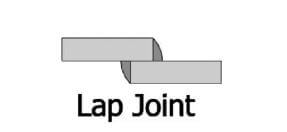
Welding joints is an edge or point where at least two metal pieces or plastic pieces are consolidated. At least two workpieces are joined with the assistance of an appropriate welding procedure to shape a solid joint.
As per the American Welding Society, there are essentially five sorts of welding joints and these are Butt, Corner, Lap, Tee and edge joint.
The 5 fundamental welding joints are
- Butt joint
- Corner joint
- Lap joint
- Tee joint and
- Edge joint
Let’s talk about each one in detail
1. Butt Joint:

The joint which is framed by putting the finishes of two sections together is called butt joint. In butt joint, the two sections lie on a similar plane or one next to the other. It is the most little difficult kind of jointly used to join metal or plastic parts together.
The diverse weld types in butt welding are
(I) Square Buttweld
(ii) Bevel groove weld
(iii) V-groove weld
(iv) J-groove weld
(v) U-groove weld
(vi) Flare-V-groove weld
(vii) Flare-slant groove butt weld
2. Corner Joint
 The joint shaped by putting the edge of two sections at the right edge is called a corner joint. Two sections which will be weld with corner joint structures the figure of L.
The joint shaped by putting the edge of two sections at the right edge is called a corner joint. Two sections which will be weld with corner joint structures the figure of L.
The distinctive weld types in corner joint are as per the following
(I) Filet weld
(ii) Spot weld
(iii) Square-notch weld or butt weld
(iv) V-notch weld
(v) Bevel-notch weld
(vi) U-notch weld
(vii) J-notch weld
(viii) Flare-V-groove weld
(ix) Edge weld
(x) Corner-spine weld
3. T-Joint
 The joint which is made by crossing two sections at the right point (i.e. at 90 degrees) and one section lie at the focal point of the other. It is called as T joint as the two-section welded look like the English letter ‘T’.
The joint which is made by crossing two sections at the right point (i.e. at 90 degrees) and one section lie at the focal point of the other. It is called as T joint as the two-section welded look like the English letter ‘T’.
The sorts of welds in T joint are as per the following
(I) Filet weld
(ii) Plug weld
(iii) Slot weld
(iv) Bevel-groove weld
(v) J-groove weld
(vi) Flare-angle groove
(vii) Melt-through weld
4. Lap Joint
 The lap joint is framed when the two sections are put one over another and then welded (see fig above). It might uneven or twofold sided. These sorts of welding joints are for the most part used to unite two pieces with various thicknesses.
The lap joint is framed when the two sections are put one over another and then welded (see fig above). It might uneven or twofold sided. These sorts of welding joints are for the most part used to unite two pieces with various thicknesses.
The Various weld types in lap joint are:
(I) Filet weld
(ii) Bevel-groove weld
(iii) J-groove weld
(iv) Plug weld
(v) Slot weld
(vi) Spot weld
(vii) Flare-slant groove weld
5. Edge Joint
The joint shaped by welding the edges of two sections together are called edge joint. This joint is used where the edges of two sheets are adjoining and are around parallel planes at the purpose of welding. In this joint the weld does not enters totally the thickness of joint, so it cannot be used in pressure and weight application.
The different weld types in this welding joint are
(I) Square-notch weld or butt weld
(ii) Bevel-notch weld
(iii) V-notch weld
(iv) J-notch weld
(v) U-notch weld
(vi) Edge-rib weld
(vii) Corner-rib weld
Others
Flimsy sheet metals are regularly flanged to deliver edge-rib or corner-spine welds. These welds are normally made without the expansion of filler metal in the light of the fact that the rib softens and gives all the filler required. Pipes and tubing can be produced using rolling and welding together strips, sheets, or plates of material.
Flare-groove joints are utilized for welding metals that, due to their shape, structure an advantageous furrow for welding, for example, a pipe against a level surface.
Determination of the correct weld joint relies upon the thickness and procedure utilized. The square welds are the most efficient for pieces more slender than 3/8″, since they don’t require the edge to be prepared. Double-groove welds are the most conservative for thicker pieces since they require less weld material and time.
The utilization of combination welding is basic for shut single-slope, shut single J, open single J, and shut twofold J butt joints. The utilization of gas and bend welding is perfect for twofold slant, shut twofold slope, open twofold slant, single-slant, and open single-angle butt welds.
The following are recorded perfect joint thicknesses for the different sorts of butt. At the point when the thickness of a butt weld is characterized it is estimated at the more slender part and does not make up for the weld support.
Conclusion
In this article, we have found out about various kinds of welding joints used to join metal or plastic parts together.
These are the most well-known 5 kinds of welding joints. Welders from all stages use these joint sorts.
You know, welding is a touch of unsafe assignment and it contains risky exhaust and gases. In this way, stay safe and pursue wellbeing precautionary measures amid. Remember to snatch the correct rigging and bits of hardware like metatarsal protects or boots, welding cook’s garments – Like Welding Shirts and jeans, head protectors, shields and so on.

Leave a Reply